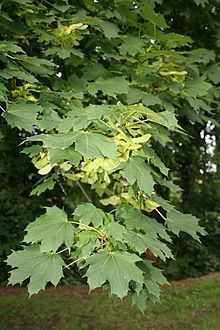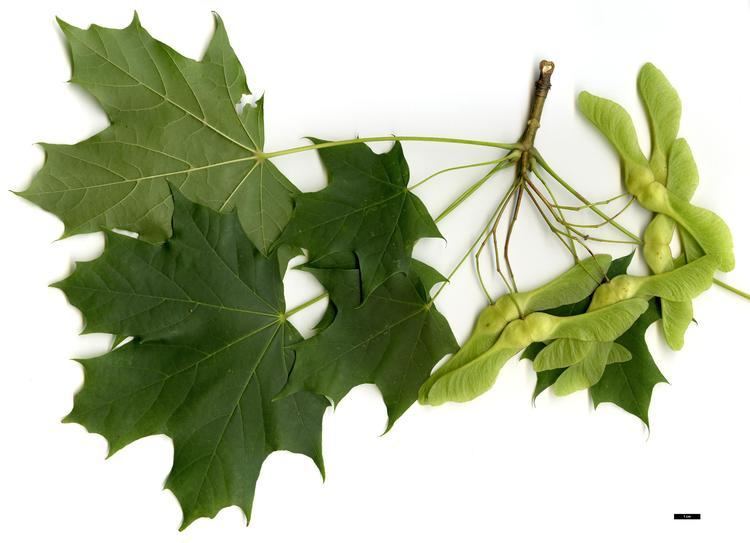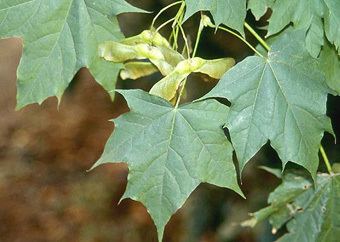Scientific name Acer platanoides Rank Species | Genus Acer Higher classification Maple | |
 | ||
Similar Maple, Syca maple, Field maple, Tilia cordata, English oak | ||
Acer platanoides globosum
Acer platanoides (Norway maple) is a species of maple native to eastern and central Europe and western Asia, from France east to Russia, north to southern Scandinavia and southeast to northern Iran. It is a member of the soapberry and lychee family.
Contents
- Acer platanoides globosum
- Acer platanoides
- Description
- Classification and identification
- Cultivation and uses
- Cultivars
- As an invasive species in North America
- Natural enemies
- References

Acer platanoides
Description

Acer platanoides is a deciduous tree, growing to 20–30 m (65–100 ft) tall with a trunk up to 1.5 m (5 ft) in diameter, and a broad, rounded crown. The bark is grey-brown and shallowly grooved. Unlike many other maples, mature trees do not tend to develop a shaggy bark. The shoots are green at first, soon becoming pale brown. The winter buds are shiny red-brown.

The leaves are opposite, palmately lobed with five lobes, 7–14 cm (2 3⁄4–5 1⁄2 in) long and 8–20 cm or 3 1⁄4–7 3⁄4 in (rarely 25 cm or 9 3⁄4 in) across; the lobes each bear one to three side teeth, and an otherwise smooth margin. The leaf petiole is 8–20 cm (3 1⁄4–7 3⁄4 in) long, and secretes a milky juice when broken. The autumn colour is usually yellow, occasionally orange-red.

The flowers are in corymbs of 15–30 together, yellow to yellow-green with five sepals and five petals 3–4 mm (0–1⁄4 in) long; flowering occurs in early spring before the new leaves emerge. The fruit is a double samara with two winged seeds. the seeds are disc-shaped, strongly flattened, 10–15 mm (3⁄8–5⁄8 in) across and 3 mm (1⁄8 in) thick. The wings are 3–5 cm (1 1⁄4–2 in) long, widely spread, approaching a 180° angle. It typically produces a large quantity of viable seeds.

Under ideal conditions in its native range, Norway maple may live up to 250 years, but often has a much shorter life expectancy in North America, sometimes only 60 years. Especially when used on streets, it can have insufficient space for its root network and is prone to the roots wrapping around themselves, girdling and killing the tree. Norway maples often cause significant damage and cleanup costs for municipalities and homeowners when branches break off in storms as it is fast-growing and does not have strong wood.
Classification and identification
The Norway maple is a member (and is the type species) of the section Platanoidea Pax, characterised by flattened, disc-shaped seeds and the shoots and leaves containing milky sap. Other related species in this section include Acer campestre (field maple), Acer cappadocicum (Cappadocian maple), Acer lobelii (Lobel's maple), and Acer truncatum (Shandong maple). From the field maple, the Norway maple is distinguished by its larger leaves with pointed, not blunt, lobes, and from the other species by the presence of one or more teeth on all of the lobes.
It is also frequently confused with the more distantly related Acer saccharum (sugar maple). The sugar maple is easy to differentiate by clear sap in the petiole (Leaf stem; Norway maple has white sap). The tips of the points on Norway maple leaves reduce to a fine "hair", while the tips of the points on sugar maple leaves are, on close inspection, rounded. On mature trees, sugar maple bark is more shaggy, while Norway maple bark has small, often criss-crossing grooves. While the shape and angle of leaf lobes vary somewhat within all maple species, the leaf lobes of Norway maple tend to have a more triangular shape, in contrast to the more squarish lobes often seen on sugar maples.
The fruits of Norway maple are paired samaras with widely diverging wings, distinguishing them from those of sycamore, Acer pseudoplatanus which are at 90 degrees to each other. Norway maple seeds are flattened, while those of sugar maple are globose. The sugar maple usually has a brighter orange autumn color, where the Norway maple is usually yellow, although some of the red-leaved cultivars appear more orange.
The tree tends to grow out leaves earlier than most maples and holds its leaves somewhat longer in autumn. Seeds begin to be forming in mid-spring and ripen over the course of the summer months, finally dropping in the fall. Unlike some other maples that wait for the soil to warm up, A. platanoides seeds require only three months of exposure to sub-40 °F (4.4 °C) temperatures and will sprout in early spring. The heavy seed crop and high germination rate contributes to its invasiveness in North America, where it forms dense monotypic stands that choke out native vegetation. It is one of the few introduced species that can successfully invade and colonize a virgin forest. By comparison, in its native range, Norway maple is rarely a dominant species and instead occurs mostly as a scattered understory tree.
Cultivation and uses
The wood is hard, yellowish-white to pale reddish, with the heartwood not distinct; it is used for furniture and turnery. Norway maple sits ambiguously between hard and soft maple with a Janka Hardness of 1,010 lbf (4,510 N). The wood is rated as non-durable to perishable in regard to decay resistance. In Europe, it is used for furniture, flooring and musical instruments. Many Stradivarius and other older Italian violins are suspected to have been constructed from Norway maple.
Norway maple has been widely taken into cultivation in other areas, including western Europe northwest of its native range. It grows north of the Arctic Circle at Tromsø, Norway. In North America, it is planted as a street and shade tree as far north as Anchorage, Alaska, having been first introduced from Europe in the 18th century. During the 1950s–60s, it became popular as a street tree due to the large-scale loss of American elms from Dutch elm disease.
It is favored due to its tall trunk and tolerance of poor, compacted soils and urban pollution, conditions that sugar maple cannot grow in. Because of the Norway maple's invasive nature, the London plane, Platanus X acerifolia, is often recommended as a pollution tolerant urban tree for planting where trees cannot be allowed to freely colonise new areas.
It has become a popular species for bonsai in Europe and is used for medium to large bonsai sizes and a multitude of styles.
Norway maples are not typically cultivated for maple syrup production due to the lower sugar content of the sap. The sugar content often approaches that of sugar maple and produces a good quality syrup. When it is plucked from the tree, Norway maple exudes a milky sap from the leaf stem, which distinguishes it from the very similar Sugar maple, Acer saccharum.
Cultivars
Many cultivars have been selected for distinctive leaf shapes or colorations, such as the dark purple of 'Crimson King' and 'Schwedleri', the variegated leaves of 'Drummondii', the light green of 'Emerald Queen', and the deeply divided, feathery leaves of 'Dissectum' and 'Lorbergii'. The purple-foliage cultivars have orange to red autumn colour. 'Columnare' is selected for its narrow upright growth, and 'Pendulum' for its weeping habit.
The cultivar 'Crimson King' has gained the Royal Horticultural Society's Award of Garden Merit.
As an invasive species in North America
The roots of Norway maples grow very close to the ground surface, starving other plants of moisture. For example, lawn grass (and even weeds) will usually not grow well beneath a Norway maple, but English Ivy, with its minimal rooting needs, may thrive. In addition, the dense canopy of Norway maples can inhibit understory growth. Some have suggested Norway maples may also release chemicals to discourage undergrowth, although this is controversial.
A. platanoides has been shown to inhibit the growth of native saplings as a canopy tree or as a sapling. The Norway maple also suffers less herbivory than the sugar maple, allowing it to gain a competitive advantage against the latter species.
As a result of these characteristics, it is considered invasive in some states, and has been banned in New Hampshire and Massachusetts. The State of New York has classified it as an invasive plant species.
The Norway maple is one of three species Meijer Garden Centers no longer sell; Meijer made this decision due to the tree's invasive nature. Despite these steps, the species is still available and widely used for urban plantings in many areas.
Natural enemies
The Norway maple is threatened in a few areas by the Asian long-horned beetle, which eats through the trunks, often killing the trees.
A number of species of Lepidoptera feed on Norway maple foliage. Norway maple is generally free of serious diseases, though can be attacked by the powdery mildew Uncinula bicornis, and verticillium wilt disease caused by Verticillium spp. "Tar spots" caused by Rhytisma acerinum infection are common but largely harmless.
Aceria pseudoplatani is a acarine mite that causes a 'felt gall' that is found on the underside of leaves of both sycamores (Acer pseudoplatanus) and Norway maple (Acer platanoides),
